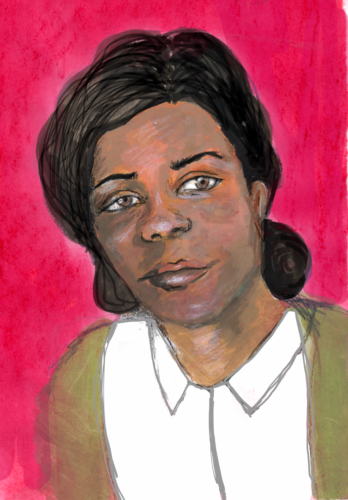Image Courtesy of Noora Said.
Bessie Blount Griffin was an inventor, nurse, physical therapist, forensic handwriting and document analyst, and avid public speaker. However, unlike many in her field, she was Black, left-handed, and a woman. Blount was born on November 24, 1914, in Hickory, now Chesapeake, Virginia, to parents George Woodard and Mary Elizabeth Griffin. In elementary school, her teachers constantly reprimanded her for writing with her left hand. After having her knuckles rapped countless times, Blount protested: if it was wrong for her to write with her left hand, then it must also be wrong to write with her right! She then taught herself how to write with her teeth and toes in response to her teacher’s disapproval.
Blount studied nursing at Keney Memorial Hospital and physical therapy at Union Junior College and Panzer College of Physical Education and Hygiene. After obtaining her degree from Union, Blount became a licensed physiotherapist at the Bronx Hospital in New York, where she helped World War II veterans with amputated limbs. She was not your average nurse. In addition to supporting amputee patients in recovering their balance and mobility, she also helped them reclaim their independence. Blount took a page out of her own book and taught the veterans how to write with their teeth and toes. “You’re not crippled, only crippled in your mind,” she said.
She continued to look for ways to give veterans autonomy over their bodies, for example, inventing a device called the Invalid Feeder to help. Patients would bite down on a tube that would activate a motor, and food would dispense through a mouthpiece in the shape of a spoon. The device shuts off after each cycle to ensure the patient would not choke. While Blount continued to work as a nurse during the day, she would work late hours in the night from 1:00 AM to 4:00 AM building her instruments. Blount did not have a degree in engineering, yet she was able to construct ingenious devices because of her passion for helping patients.
Continuing to invent, Blount created more apparatuses, such as disposable kidney-shaped basins to dispose of bodily waste and the “portable receptacle support,” similar to the “invalid feeder,” with the addition of a neck brace with a bowl. The latter received a patent under her name on April 24, 1951, making Blount one of the first officially recognized inventors in physical therapy. She had many other accomplishments from becoming a handwriting analyst for several police departments––including Scotland Yard in England, where she was the first Black American woman to have trained there––to starting her own consulting business in her hometown.
However, Blount’s accomplishments did not come without challenges. After inventing the “invalid feeder,” she wanted to bring relief to others around the country, but the US military refused to pay Blount a fair amount. She also tried to sell her devices to the American Veterans Association, but they did not want to support her due to her race and gender. Blount wanted to prove that her inventions themselves were impressive and did not want to tie her inventions to her identity as a Black woman. She was not driven by financial motivation but rather by the idea of helping society progress through her innovations. Even after being turned down by many different organizations, she eventually donated the “invalid feeder” to France, where the French used it in military hospitals. Belgium also bought her disposable basins.
At first glance, Bessie Blount Griffin is an accomplished inventor and nurse. However, to those who know her story, she is a humanitarian who worked for the advancement of society. Today, her influence on the medical field can be seen in hospitals worldwide. Her basins inspired many of those that are used today, and European hospitals still use the “invalid feeder.” Despite the challenges, discrimination, and inequity she faced as a Black woman, Blount leaves a long-lasting legacy as her inventions continue to benefit mankind.

